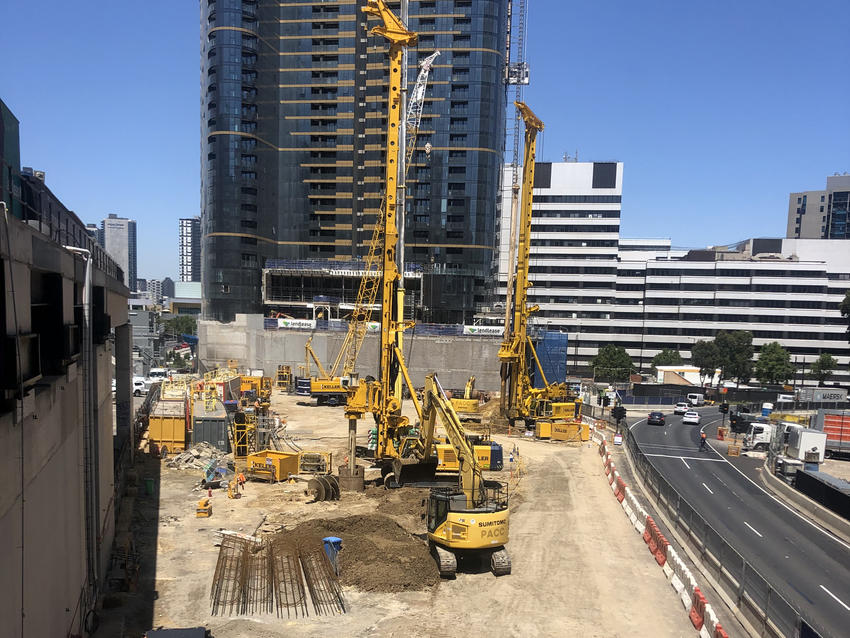After successfully completing foundation works for two towers at the landmark Melbourne Quarter precinct, developer Lendlease once again chose Keller to deliver the biggest phase of the programme yet: piling works for the billion-dollar Melbourne Quarter Tower.

The Melbourne Quarter promises to be an iconic area in the city’s bustling central business district, with accommodation for 13,000 workers and 3,000 residents alongside welcoming green spaces and numerous retailers, restaurants and cafes.
Over the past few years, Keller has constructed foundations for the development’s first two towers – 2 Melbourne Quarter and the residential East Tower. With excellent knowledge of the area’s geological conditions, and a track record of quality, safety and efficiency, again made Keller the strong choice for Lendlease this time around.
An economical solution
However, the real key to winning the project was the design, as David McKerrell, Project Manager explains. “The tender period was relatively short and the client was looking for a quick turnaround, from award to detailed design to construction. One of the reasons we were awarded the works was that we offered numerous value-management options at the tender stage, which created significant potential savings to the client. We were also very responsive to the client’s requests once new design information became available.
“The ground conditions were also very complex. The upper area of the site is underlain with high to very high-strength older volcanic basalts from depths of around 6-15m. Below that is Werribee Formation, a clayey-silty-sandy material not typically self-supporting, which requires piles to have casings or support fluids. This was found at around 15-25m across the site and overlays a siltstone bedrock at depths of 30-40m-plus.”
Having successfully used bored piles before on the 2MQ tower, the team once again opted for this trusted technique, planning 270 piles with diameters ranging from 600mm up to 1,800mm, installed up to depths of almost 50m. The lightly loaded piles were designed to be founded in the upper basalt to reduce the risk of settlement, with the higher loads transferred to deeper piles secured in the bedrock. The team also had to ensure the piles didn’t effect existing piles for a rail-crash barrier immediately adjacent to the site.
Once the design was established, the crew mobilised on site just before Christmas 2019.
A bigger challenge
“This was a much bigger project than the previous one at this site, with more piles, larger diameters and greater depths,” says David. “There was a lot more sequencing involved and we had to manage the logistics carefully; we had three piling rigs, three excavators, two cranes, several polymer tanks and a peak workforce of 21, which quickly made the 7,000m2 site feel tight. There was much planning every day to work out where we needed to be a few days ahead to keep things running smoothly and efficiently.”
To further complicate the project, part of the site was divided by a main arterial road. This section was long and narrow – around 15m wide – and was where many of the large, 1,800mm diameter piles needed to be constructed. Again, the team had to thoughtfully sequence works to complete the large polymer concrete pours within the allotted shift time of around 10 hours. As with all Keller projects, safety is the main priority, so David and the team had to make sure no polymer spilt as it was pumped over the road to the smaller site.
Knowledge and experience pay off
Around March, Australia experienced the first wave of Covid-19 cases. “Fortunately it didn’t impact us too much, but early on we weren’t sure how it was going to develop,” he says. “We took it very seriously and put a series of controls in place around social distancing, managing breaks and travel arrangements to protect the team. All credit to Lendlease as well for being very proactive – looking at other construction sites around the city at that time I would say ours was by far the best.”
Keller wrapped up piling works in mid-June – another successful project for this high-profile development.
“We’ve also got a lot of experience of drilling under fluids which saved us time. There aren’t many in this market that could have done this job in the timeframe, and we’re delighted it’s gone so smoothly for ourselves and our client.”